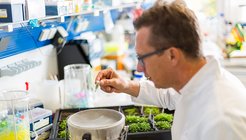“The end product is what matters”
Detlef Weigel, Director at the Max Planck Institute for Developmental Biology, explains why genome editing offers a targeted way of breeding better crops
Greater resistance to pests, less sensitivity to drought, higher yields – this is just a small selection of the requirements that crops will have to fulfil in future. Humanity needs new crops that can withstand the changes arising from global warming and can meet the growing demand for food. With the help of a new method called genome editing, scientists are seeking to develop new crop varieties more efficiently than before. If no foreign genes are inserted into these plants they cannot be distinguished from plants that have been bred using traditional methods. For this reason, Detlef Weigel from the Tübingen-based Max Planck Institute for Developmental Biology, together with colleagues from the USA and China, is asking for genome-edited plant varieties of this kind not to be classified as genetically modified plants.

Detlef Weigel is in favour of classifying genome-edited plants like traditionally bred plants.
Mr Weigel, how are new varieties bred from crops today?
Detlef Weigel: It is important to realize that traditional breeding also aims to alter the DNA of the plants. For example, if you would like to obtain a new plant that can withstand drought and produce high yields, you can cross existing varieties which are resistant to drought or produce particularly high yields. The genes for these traits are newly mixed in the descendants’ DNA and some plants receive the genes for both traits. Chemical substances or radiation can also be used to generate mutations somewhere in the genetic code. Plants with new traits can also arise in this way. However, it is very time-consuming and complicated to seek out plants with the desired traits from thousands of mutants.
What is the difference between genome-edited and genetically modified plants?
With traditional genetic engineering, genes are often introduced into a plant’s DNA that do not arise naturally in the species, for example genes for resistance to a herbicide. Different processes exist for this: for example, the genes can be ‘shot’ into the plant cells using a kind of ‘gene gun’. With genome editing, we cut the DNA with a protein at a predefined location. The genome editing method known as CRISPR/Cas9 has become the most common method. We can then modify the DNA at the interface or insert new sections. So genome editing should be viewed as a variant of mutation breeding, with the difference that the generation of particular mutations is targeted.
The major advantage here is that these modifications can be obtained in the same way as they are made in traditional breeding and crossing experiments. For example, individual letters of the genetic code can be exchanged. This corresponds to a modification which can also arise through natural mutation. Short sections of DNA can also be inserted and, in this way, genes from a species can be replaced with genes from its other varieties or from closely related species – something that is also done in traditional cross-breeding.
The criticism regarding genetically modified plants is aroused by the aforementioned ‘foreign genes’ in particular. Do genome-edited plants also contain such foreign DNA?
The genetic information for the cutting protein is usually inserted into the plant’s DNA so that it can be formed in the plant cells. This gene does not arise naturally in plants and is, therefore, foreign DNA. Following the successful modification of the genome, however, it can be completely removed. Using the analysis methods available today, it is possible to ensure that a genome-edited plant no longer contains any foreign DNA. Genome editing can also be used to insert completely foreign genes into the genome – as is the case in traditional genetic engineering. However, this kind of genome editing should be subject to different regulations than the kind that is used to make minor modifications.
Is it possible to distinguish at all between genome-edited and traditionally bred plants?
If no foreign genes are inserted, then, no, it is not possible. A plant that has been modified using genome editing does not differ in any way from a plant whose genome was altered through breeding. At the end of the process, there is nothing to indicate how the new variety arose.
So genome-edited plants should not be treated like genetically modified plants if they do not contain any foreign DNA?
Exactly! This is why we are asking for them to be classified like traditionally bred plants. In our view, how a plant variety came into being does not make any difference; the end product alone is what matters. In my view, it does not make any sense to classify plants as different if it is not possible to say how they came into being.
Is this possible from a legal point of view or would it require a change in the law?
The German Genetic Engineering Act states that the descendants of a genetically-modified plant must also be classified as genetically modified. So the fact that genome-edited plants temporarily contained the gene for the cutting protein would make them and their descendents genetically modified plants forever – despite the fact that the foreign gene was removed without trace. This was certainly not the intention of the legislator as genome engineering did not yet exist when the Genetic Engineering Act was passed. So we suggest that the Genetic Engineering Act should not be applied to genome-edited plants.
Interview: Harald Rösch
